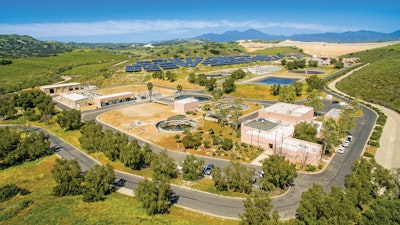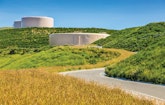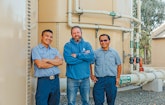
Khoa Nguyen (left) and Chris Ingram log levels of neutralizing chemicals at the Santa Margarita Water District’s Mission Viejo facility.
Interested in Infrastructure?
Get Infrastructure articles, news and videos right in your inbox! Sign up now.
Infrastructure + Get AlertsRubber dams. Public-private partnerships. These and other ideas are flowing freely at the Santa Margarita Water District headquarters as officials work to meet the challenge of providing abundant and reliably sourced water for the district’s Southern California customers.
The district is situated south of Los Angeles and serves parts of Mission Viejo, Rancho Santa Margarita and several other small communities. Its boundaries angle down across a large bloc of unincorporated Orange County before stopping short of the Pacific coast. In all, some 160,000 customers depend on the district for their water. Their dependency has district officials methodically working to ensure the water will be there for them in the years ahead.
“We import all of our potable water,” says Don Bunts, deputy general manager. “We’re looking at building some local reliability and sustainability in the event something severs our two sources of imported water.”
The two sources are provided through the Metropolitan Water District of Southern California — Northern California and the Colorado River. To augment that distant supply, the district is developing local sources including the San Juan watershed. The watershed underlies the district’s boundaries and contains two usually dry creek beds that each year channel some 7 billion gallons of watershed runoff into the Pacific Ocean.
“We already are capturing some of the urban runoff in the creeks, but we are going to increase the value of that water,” Bunts says. What he calls “a perfect storm” of circumstances brought home to district administration and board members the need for additional water sources. Climate change concern coincided with one of the periodic droughts that visit the semiarid region, driving the price of imported water to $1,100 an acre-foot, thereby drawing more attention from water officials.
“Some of this planning was coming together before, but the drought drove it to the forefront of people’s consciousness,” Bunts says. Local studies were initiated to determine how to develop more local and sustainable water sources and — no surprise — the San Juan watershed popped up as a partial solution.
Inflatable dams
Three years’ environmental impact statements were necessary to satisfy regulatory agencies and skeptics that the project was environmentally benign. Specifically, concern about disturbing the life cycle of steelhead trout was raised, reflecting ongoing efforts to reestablish the species, which hasn’t been seen in years, according to Bunts. The project was certified OK in July.
“It worked out very well,” he says. “When we started the project, we reached out to some environmental groups and received input on some things we hadn’t really thought about.”
The $120 million project will capture runoff and help recharge the local underground aquifer. A key component of the effort will be the deployment of three inflatable dams. The 5/8-inch-thick rubber tubes are 7 feet high and 125 feet long. Each tube will rest on a concrete foundation inside a small berm of soil and will be covered with an aesthetically pleasing soft material. The tubes are designed to slow and back up runoff so the water can soak into the ground and the underlying aquifer, from which it can be drawn later.
The tube solution sounds pretty impermanent as infrastructure goes, but that’s by design. While the tubes can be inflated in 45 minutes, they can be deflated in half that time or quicker. This is important because in the event of a threatening storm, air will be released from the tubes so that the ensuing rush of stormwater can flow downstream and into the ocean rather than spread rapidly and flood the local area.
Finding balance
The payoff of this investment by the district is, of course, water. Construction between now and 2030 will follow a three-phase schedule with water accrual occurring at the completion of each stage. In 18 to 24 months, anywhere from 700 acre-feet per year to twice that much will begin to be added to the aquifer. By the time the last phase is completed, the district will be accumulating about 8,000 acre-feet per year, enough water to sustain 50,000 families.
“The board strategy is that, instead of having 100% of potable water imported, we will source 30% to 50% of potable water from local supplies,” Bunts says. “That’s about what indoor use is, which means if we run into an emergency, we can turn off landscaping water and locally provide all the water we need to sustain life.”
The district’s approach is to look at the entire portfolio of responsibilities and find balance in sourcing and handling water. “We don’t want to hang our hat on just one thing,” he says, before switching metaphors to add, “We don’t want to put all our eggs in one basket.”
Consequently, additional water sourcing is only part of the story in the Santa Margarita Water District. Steady development of recycled water capacity is another. The more water can be reused, the more it can supplant potable water use, thereby preserving the drinkable water for drinking. Some $3 million to $7 million per year has been budgeted by the district for enhancing the collection, storage and treatment of wastewater for reuse.
Fully gulpable
The Association of California Water Agencies this year awarded the district its Clair A. Hill Agency Award for Excellence. The agency cited the district’s unprecedented partnership with the city of Mission Viejo and the privately held Lake Mission Viejo Association to fast-track, finance and build an advanced water treatment facility in a mere eight months. The new facility’s water is pumped into Lake Mission Viejo — the first swimming and recreational lake in California to be refilled with recycled water.
Using the purified effluent to top off the 125-acre lake ends 40 years’ dumping drinkable water into the lake and will annually save 114 million gallons of potable water. The association came to the district seeking possible solutions after the state complained about its long-standing practice of using drinking water.
“The lake is on their city emblem, and they saw a danger of water shortage in the community,” Bunts says. “They put up the money for the additional treatment plant. A city putting money into a district water project — that’s a first.”
He adds that association management also “did the heavy lifting” of reassuring the public about putting treated wastewater into a recreational lake. “The water in the lake is fully ‘gulpable,’ as far as that goes,” Bunts says, referring to inadvertent swallowing of lake water by swimmers and boaters. “I probably wouldn’t recommend a steady diet of it.”
Which brings up the possibility of treating wastewater to a point where it is fully drinkable. “We do have plans for that. I’m not sure we will ever have to go direct, and I’m not sure the public is quite there yet. Actually, we feel you could drink this water that has received advanced treatment, with the addition of some other disinfectants.”
For now, the district is content to dump treated water into storage ponds and aquifers for additional purification later. To that end, the Santa Margarita district is investing $123 million in constructing another reservoir for containment of recycled water. A Trampas Canyon facility will be an enlarged version of a dam built on the site some 40 years ago for a sand-cleaning operation. The property is already permitted for a reservoir, so the district is simply tearing down the old dam and building one with doubled holding capacity.
Long-term economics
A new round of homebuilding triggered the Trampas Canyon facility; and future demographic and population trends continue to put pressure on existing water supplies. Yet another district response to growth is the search for local suppliers of groundwater in neighboring communities such as San Bernardino and Riverside. And it has signed memos of understanding with some adjacent water agencies that are exploring the feasibility of ocean desalination projects. After all, billions and billions of gallons of water — albeit salty — are splashing ashore just a few miles away.
“I hedge my bets by saying desalination is a possible ultimate solution, depending upon where it is,” Bunts says. “It works in San Diego, and it may work for other places.”
The technology involved pushes seawater through membranes to filter out the salt, but it is an energy-intensive process and, hence, an expensive one. As the technology improves and the cost of the process comes down a bit, it will become more attractive. Bunts notes that the cost differential between imported water and desalinated water continues to shrink.
Water rates have been rising for some time — the typical customer with a 3/4-inch meter pays $23.05 a month — and the district works to convey to its customers just why that is. “We try to take the approach that we are in this for the long haul,” Bunts says. “We are going to need water forever. We are trying to do things that are the most economical for the long term.”
While public support has been demonstrated, Bunts says educating customers about costs and water conservation is a constant need. He credits district personnel, from administrators to people in the field, for the organization’s positive and progressive culture in the face of all these challenges.
“They have a tremendous amount of pride in what we are doing here to make things better and to do it smarter and faster and cheaper. Top to bottom, we have the people here who can do that.”
Uncovering the possibilities
The thinking at Santa Margarita (California) Water District is that 55 years of existence makes it old enough to have established itself and young enough to still be capable of imaginative thinking. Don Bunts, deputy general manager, credits a forward-looking board for this progressive mindset.
“We are a relatively new district in the general scheme of things, so we can see things with fresh eyes,” he says. “We have people here who think outside the box, and they aren’t ridiculed for it. Their thoughts are incorporated into the conceptualizing phase and kicked around the room for a couple hours, or months, or years until their ideas become feasible. The board has given us that latitude.”
He cites the district’s participation in a Cadiz Valley water project as an example of thinking “way outside the box.” An aquifer under the valley’s Mojave Desert floor tests out at 50-75,000 acre-feet per year so the city signed on to buy 5,000 acre-feet per year once the project comes to fruition. That may not be anytime soon. “An environmental study was done and the project certified, but it has become a political project now,” he says.
Reaching out to tap a desert aquifer, keeping lines of communication open with agencies involved in desalination projects, damming dry creek beds for their runoff potential — not a stone is being left unturned in the district’s search for local water. Bunts says the various initiatives encourage him to believe the district will deliver the promised water in the future.
“I think we are on the right path,” he says. “The bar keeps being raised because of external drivers, but we are addressing issues as they arise. We are not boxing ourselves into a corner. Our board has taken a proactive approach. They do not want to just sit and talk about the issues. They are encouraging innovation and challenging staff to come up with solutions.”
Consequently, Bunts believes the district and its customers have a viable future.
“We are ahead of the curve. If we have a water emergency tomorrow, we might have difficulty addressing it, but in a couple of years, I think we are going to be in pretty good shape. I don’t think most Southern California districts can say that.”











